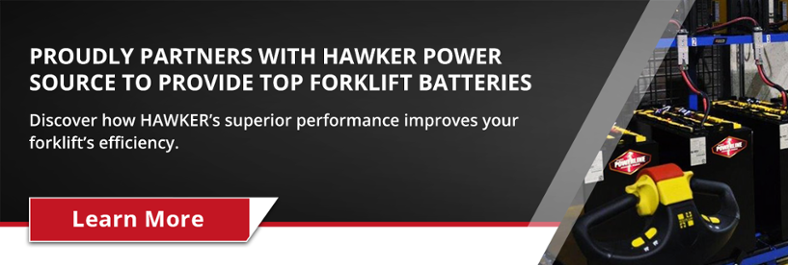For many warehouses and distribution centers, a well-maintained fleet of forklift trucks is important. Forklifts help move massive amounts of product quickly and efficiently as needed to keep the warehouse operating at peak efficiency.
Many modern warehouses use industrial battery-powered forklifts to minimize the risks and emissions associated with combustible fuel-powered drivetrains. To keep these electric forklifts operating at peak efficiency, the forklift batteries used to power them need to be kept in top condition.
Worn out forklift batteries may not put out a sufficient charge to safely power your forklifts. In fact, the unstable electrical output from degraded industrial batteries may cause damage to forklift systems. So, industrial battery maintenance is a must.
However, sooner or later, all of your forklift batteries will need to be replaced. Each forklift battery can only withstand so many charging cycles before they degrade (typically around 1,500). Aside from batteries simply losing efficacy over time, there are other ways that they can be damaged and cause damage to your forklifts. When batteries become worn out or damaged, it is necessary to replace them—preferably before they can cause damage to your forklifts or harm an employee.
With this in mind, here are a few warning signs that you need to replace your forklift batteries:
1: Excessive Forklift Battery Sulfation
Many electric forklift batteries are lead-acid type batteries. The catalyst solution used in these batteries contains both sulfuric acid and water. Over time, the water evaporates and needs to be replaced (preferably with purified water for industrial battery maintenance reasons). When there is too little water in the forklift battery, or it is improperly charged, the sulfuric acid in the catalyst solution may collect on the battery’s plates. This process (and the residue) is known as battery sulfation.
Excessively sulfated batteries will lose cranking power and take longer to charge. If left alone for too long, the battery plates could become permanently damaged.
So, if a forklift operator finds that, during an inspection prior to charging forklift batteries, the batteries are excessively sulfated to the point where the contaminant cannot be removed, then it may be best to replace the batteries.
2: Abnormally Fast Drain After Charging Forklift Batteries
Another obvious sign that a forklift battery should be replaced is if it doesn’t seem to be able to hold a charge. When charging forklift batteries, it can help to make a note of how long a charge lasted, and at what level each battery was when it was charged in a maintenance log.
Ideally, batteries should be charged when they reach the 20-30% range to maximize their useful life. Otherwise, you may find that your batteries will lose their ability to hold a charge quicker than they should. Remember, batteries are only good for so many charging cycles, so using “opportunity charging” to top off a battery that’s at 70% is just shortening the battery’s useful life without letting you get as much done.
3: Electric Forklifts Have Reduced Performance/Dim Displays
After plugging in the industrial battery, if a forklift operator notices that the forklift’s displays are dim or flicker (or don’t power on at all), it might be an indication that the battery is simply unable to supply enough power. In extreme cases, the forklift may not be able to move at all.
If this happens, it’s important to check to make sure the connection between the battery and the forklift is clean and secure, as debris or loose connections could be to blame. Also, be sure to inspect the interior of the forklift battery for signs of excessive sulfation.
4: Spilled Acid On the Forklift Battery’s Exterior
If there is acid collecting on the exterior of the battery, it should be checked for signs of damage immediately, and possibly prepared for proper disposal. Acid leaking out of the battery can pose a severe health and safety hazard to employees attempting to handle it, and anyone inspecting or handling damaged industrial batteries should be sure to wear gloves, goggles, and other protective wear to keep the acid from touching them.
This may be caused by a loose seal or an overfilled battery, as catalytic fluid could splash around the battery’s interior while the forklift is in operation. However, it is not recommended that you try to replace lost sulfuric acid in lead-acid industrial batteries. Leakage of acid should be cause to send the battery in for repair or replacement by the manufacturer—if not outright disposal. It is strongly recommended that you do not try to fix such an issue “in-house.”
5: Corroded/Damaged Forklift Battery Terminals
Electric forklift batteries are typically built to be highly durable. However, even the most durable warehouse equipment will break if subjected to enough abuse. For example, if industrial battery maintenance falls behind schedule for too long, or if something impacts the battery terminals, the damage could keep the battery from working properly.
Corroded terminals can keep the battery from efficiently transferring power to the forklift, as well as impair charging. Damage to a battery’s casing can cause leaks or prevent the terminals from making complete and secure contact with the forklift.
If a battery has corroded or damaged terminals, it may be necessary to send it to the manufacturer for repair or replacement.
These are a few of the warning signs that you might need to replace an electric forklift battery as soon as possible. If you need help optimizing your industrial battery maintenance schedule, or for finding the right electric forklift batteries for your warehouse, contact Southern States Motive Power, your forklift battery expert in Tampa, Orlando, Jacksonville and more!






